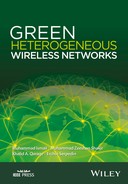Preface
This book focuses on the emerging research topic ‘green (energy- efficient) wireless networks’ that has drawn huge attention recently from both academia and industry. This topic is highly motivated due to important environmental, financial and quality-of-experience (QoE) considerations. Due to such concerns, various solutions have been proposed to enable efficient energy usage in wireless networks, and these approaches are referred to as green wireless communications and networking. The term ‘green’ emphasizes the environmental dimension of the proposed solutions. Hence, it is not sufficient to present a cost-effective solution unless it is eco-friendly.
In this book, we mainly focus on energy-efficient techniques in base stations (BSs) and mobile terminals (MTs) as they constitute the major sources of energy consumption in wireless access networks, from the operator and user perspectives. Furthermore, this book targets the heterogeneous nature of the wireless communication medium, and therefore, the book is entitled ‘Green Heterogeneous Wireless Networks’. The wireless communication medium has become a heterogeneous environment with overlapped coverage due to the co-existence of different cells (macro, micro, pico and femto), networks (cellular networks, wireless local areas networks and wireless metropolitan area networks) and technologies (radio frequency, device-to-device (D2D) and visible light communications (VLC)). In such a networking environment, MTs are equipped with multiple radio interfaces. Through multi-homing capability, an MT can maintain multiple simultaneous associations with different networks. Besides enhancing the achieved data rate through bandwidth aggregation, the heterogeneous wireless medium together with the multi-homing service can enhance the energy efficiency of network operators and mobile users.
This book consists of three parts. The first part provides an introduction to the ‘green networks’ concept and identifies the key problems associated with the existing green solutions. The first part consists of two chapters. The first chapter discusses the need for green (energy-efficient) communications, the modelling techniques used for energy efficiency and call traffic in wireless networks and different performance metrics. The second chapter reviews the existing solutions for green networking at different call traffic load conditions. It covers the green solutions adopted by different standards (e.g. 3GPP). Limitations and key problems of the existing solutions are also discussed.
The second part of the book targets the green multi-homing resource allocation problem, and it consists of four chapters. The first chapter introduces the green multi-homing resource allocation problem and discusses its potential benefits andchallenges. The limitations of the existing multi-homing green solutions are discussed and practical aspects that should be accounted for are presented to assist engineers and network operators in building green multi-homing solutions. These limitations and practical considerations are then discussed in detail in the following chapters. The second chapter addresses a major limitation of practical value in the existing green downlink multi-homing resource allocation strategies. Specifically, the existing solutions implicitly assume that all networks are willing to cooperate unconditionally for energy saving, which is not practical, and therefore, we present a novel win–win resource allocation mechanism that enables energy saving for network operators. Furthermore, a radio resource allocation framework that accounts for the in-device coexistence (IDC) interference between the LTE and WiFi networks is also presented. The third chapter addresses a major limitation of existing research on green uplink multi-homing resource allocation for data calls. Specifically, existing solutions adopt a single-user system model, which is not practical for uplink resource allocation, and hence we present a novel joint bandwidth and power allocation framework in a multi-user system that maximizes the minimum energy efficiency among all MTs in service. In addition, uplink resource allocation for sustainable multi-homing video transmission is also discussed. An energy management subsystem that adapts the MT energy consumption during the call to achieve at least the target video quality lower bound is presented. The last chapter of the second part of the book presents a novel framework that integrates femto cells with VLC for a green downlink multi-homing resource allocation strategy to exploit jointly their benefits in energy saving while overcoming their practical limitations in terms of VLC reliability and femto-cell high energy consumption as compared to VLC.
The third part of the book addresses green network management solutions and consists of four chapters. The first chapter addresses BS on–off switching methods for energy saving. Two mechanisms are presented to serve the mobile users while switching off the BSs. One mechanism relies on a dense deployment of small-cells while the other mechanism relies on a cooperative networking technique. Furthermore, existing solutions mainly shift the energy consumption burden from the network operators to mobile users, which is not practical as it will drain the mobile user terminals at faster rates, and consequently, we present a novel dynamic planning approach with a balanced energy saving strategy for network operators and mobile users. The second chapter presents a novel deployment model for small-cells and cell-on-edge deployment to enhance energy efficiency of the networks. The third chapter presents a novel deployment of D2D communications and their successful integration into heterogeneous networks. This chapter presents also an end-to-end analysis of power consumption in the whole network and stresses out the significance of device-centric communications for ‘greener networks’. The last chapter in this part of the book presents an emerging device centric green approach for content exchange/download between the devices by exploiting the multihoming and packet split over multiple interfaces in D2D links.
Muhammad Ismail, Muhammad Zeeshan Shakir,
Khalid A. Qaraqe, and Erchin Serpedin
Doha, Qatar
June 2016.
